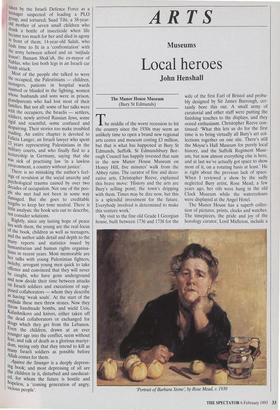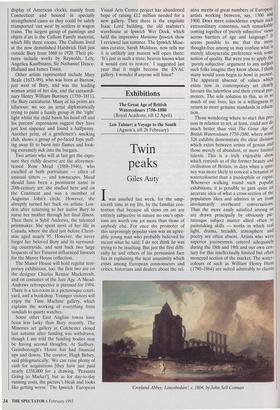ARTS
Museums
Local heroes
John Henshall
The Manor House Museum (Bury St Edmunds)
The middle of the worst recession to hit the country since the 1930s may seem an unlikely time to open a brand new regional arts centre and museum costing £3 million, but that is what has happened at Bury St Edmunds, Suffolk. St Edmundsbury Bor- ough Council has happily invested that sum in the new Manor House Museum on Honey Hill, five minutes' walk from the Abbey ruins. The curator of fine and deco- rative arts, Christopher Reeve, explained this brave move: 'History and the arts are Bury's selling point; the town's dripping with them. Times may be dire now, but this . is a splendid investment for the future. Everybody involved is determined to make this venture work.'
My visit to the fine old Grade I Georgian house, built between 1736 and 1738 for the
wife of the first Earl of Bristol and proba- bly designed by Sir James Burrough, cer- tainly bore this out. A small army of curatorial and other staff were putting the finishing touches to the displays, and they oozed enthusiasm. Christopher Reeve con- tinued: 'What this lets us do for the first time is to bring virtually all Bury's art col- lections together on one site. There's still the Moyse's Hall Museum for purely local history, and the Suffolk Regiment Muse- um, but now almost everything else is here, . and at last we've actually got space to show most of it, on a rotating basis at least.' He is right about the previous lack of space. When I reviewed a show by the sadly neglected Bury artist, Rose Mead, a few years ago, her oils were hung in the old Clock Museum while the watercolours were displayed at the Angel Hotel.
The Manor House has a superb collec- tion of pictures, prints, clocks and watches. The timepieces, the pride and joy of the horology curator, Lord Midleton, include a `Portrait of Barbara Stone', by Rose Mead, c. 1930 display of American clocks, mainly from Connecticut and housed in specially strengthened cases so they could be safely transported 'out west' by settlers in wagon trains. The largest group of paintings and objets d'art is the Cullum Family material, which fills three rooms. The Cullums lived at the now demolished Hardwick Hall just outside Bury from 1660 to 1920. Their pic- tures include works by Reynolds, Lely, Angelica Kauffmann, Sir Nathaniel Dance- Holland and James Tissot.
Other artists represented include Mary Beale (1633-99), who was born at Barrow, just west of Bury, and was the leading woman artist of her day, and the extraordi- nary Henry William Bunbury (1750-1811), the Bury caricaturist. Many of his prints are hilarious: we see an artist diplomatically trying to paint a family group in the 'right' light whilst the child bawls his head off and his parents' expressions suggest they have just lost sixpence and found a halfpenny. Another print, of a gentlemen's smoking club, shows a group of po-faced fops puff- ing away fit to burst into flames and look- ing extremely sick into the bargain.
Two artists who will at last get the expo- sure they richly deserve are the aforemen- tioned Rose Mead (1868-1946), who excelled at both portraiture — often of unusual sitters — and townscapes. Mead should have been a prominent name in 20th-century art: she studied here and on the Continent and was a member of Augustus John's circle. However, she abruptly turned her back on artistic Lon- don after returning to her native Bury to nurse her mother through her final illness. Then there is Sybil Andrews, the talented printmaker. She spent most of her life in Canada, where she died just before Christ- mas aged nearly 95. However, she never forgot her beloved Bury and its surround- ing countryside, and sent back two large bequests of her Futurist-influenced linocuts for the Manor House collection.
The Manor House will hold regular tem- porary exhibitions, too: the first two are on the designer Charles Rennie Mackintosh, and on costumes of the Jazz Age. A Mead- Andrews retrospective is planned for 1994. There is a tea-room in a picturesque court- yard, and a bookshop. Younger visitors will enjoy the Time Machine gallery, which explains the working of everything from sundials to quartz watches.
Some other East Anglian towns have been less lucky than Bury recently. The Minories art gallery at Colchester closed last autumn after funding was withdrawn, though I am told the funding bodies may be having second thoughts. At Sudbury, Gainsborough's House has had financial ups and downs. The curator, Hugh Betsey, said phlegmatically: 'We can raise plenty of cash for acquisitions [they have just paid nearly £358,000 for a drawing, 'Peasants Going to Market'], but as for day-to-day running costs, the picture's bleak and looks like getting worse.' The Ipswich European
Visual Arts Centre project has abandoned hope of raising £12 million needed for a new gallery. Then there is the exquisite Isaac Lord building, the old maltster's warehouse at Ipswich Wet Dock, which held the impressive Maritime Ipswich show I reviewed last summer. The Ipswich Muse- ums curator, Sarah Muldoon, now tells me it is unlikely any musem will open there: `It's just in such a state; heaven knows what it would cost to restore.' I suggested last year that it might become the EVAC gallery. I wonder if anyone will listen?























































 Previous page
Previous page